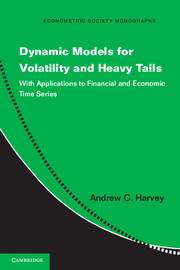 Dynamic Models for Volatility and Heavy Tails
Dynamic Models for Volatility and Heavy Tails Book contents
- Frontmatter
- Contents
- Preface
- Acronyms and Abbreviations
- 1 Introduction
- 2 Statistical Distributions and Asymptotic Theory
- 3 Location
- 4 Scale
- 5 Location/Scale Models for Non-negative Variables
- 6 Dynamic Kernel Density Estimation and Time-Varying Quantiles
- 7 Multivariate Models, Correlation and Association
- 8 Conclusions and Further Directions
- A Derivation of Formulae in the Information Matrix
- B Autocorrelation Functions
- C GED Information Matrix
- D The Order of GARCH Models
- E Computer Programs
- Bibliography
- Author Index
- Subject Index
- Other titles in the series
2 - Statistical Distributions and Asymptotic Theory
Published online by Cambridge University Press: 05 May 2013
- Frontmatter
- Contents
- Preface
- Acronyms and Abbreviations
- 1 Introduction
- 2 Statistical Distributions and Asymptotic Theory
- 3 Location
- 4 Scale
- 5 Location/Scale Models for Non-negative Variables
- 6 Dynamic Kernel Density Estimation and Time-Varying Quantiles
- 7 Multivariate Models, Correlation and Association
- 8 Conclusions and Further Directions
- A Derivation of Formulae in the Information Matrix
- B Autocorrelation Functions
- C GED Information Matrix
- D The Order of GARCH Models
- E Computer Programs
- Bibliography
- Author Index
- Subject Index
- Other titles in the series
Summary
The asymptotic distribution theory for a wide range of dynamic conditional score models is of crucial importance in showing their viability. The information matrix can be obtained explicitly, and the proof of the asymptotic normality of the maximum likelihood estimators is relatively straightforward. This contrasts with the situation for most other classes of nonlinear dynamic models. For example, no explicit information matrix is available for the most commonly used GARCH models, whereas for EGARCH models there is virtually no asymptotic theory for ML estimation.
Section 2.1 reviews the properties of the distributions that feature most prominently in this book. The interconnections between the various distributions provide the building blocks for the theory that follows. Maximum likelihood estimation is discussed for static models before moving on to the main theorems in Section 2.3. It is shown that, for the class of models in question, the information matrix breaks down into two parts. One part is the information matrix of the static model, whereas the other is a matrix linked to the equation for the dynamics. This second matrix depends on properties of the conditional score. Its form is the same for all the models described in Chapters 3, 4 and 5, and the sections on asymptotic theory in these chapters simply link up the two components of the information matrix to give the full picture. The asymptotic theory points to certain restrictions on the dynamic parameters, and the form taken by these restrictions is investigated in later chapters.
- Type
- Chapter
- Information
- Dynamic Models for Volatility and Heavy TailsWith Applications to Financial and Economic Time Series, pp. 19 - 58Publisher: Cambridge University PressPrint publication year: 2013


